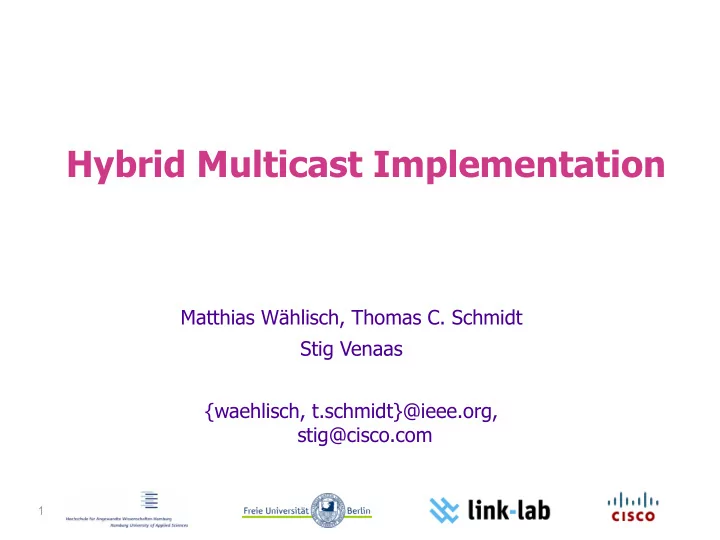

Hybrid Multicast Implementation Matthias Wählisch, Thomas C. Schmidt Stig Venaas {waehlisch, t.schmidt}@ieee.org, stig@cisco.com 1
Agenda o Motivation o Analytical Performance Evaluation o Integration into Real-world Mcast Protocols o Conclusion 2
Motivation – No Inter-domain Multicast 3
Hybrid Multicast Idea: o Connect different multicast islands o Combine different technologies to provide group communication Challenges: o Allow for a self-organizing, unified distribution o Find ‚natural‘ way for the interplay of mcast protocols o Performance of hybrid scenarios 4
A Hybrid Picture: Shared Tree 5
Ingredients for Hybrid Multicast o Multicast routing protocols in overlay and underlay - Definition for the interplay o Appropriate multicast naming and mapping scheme � Common Multicast API o Gateways - Easy to use and extendable system architecture - Discovery and configuration of gateways � HAMcast middleware 6
Scribe – RP-based Overlay Multicast (Castro et al 2002) o Large-scale distribution service based on Pastry o Rendezvous Point chosen from Pastry nodes - Choice according to group key ownership - RP roots shared distribution tree (analogue PIM-SM) o Shared tree created according to reverse path forwarding - Nodes hold children tables for forwarding - New receiver routes a SUBSCRIBE towards the RP - Subscribe intercepted by intermediate nodes to update children table, reverse forwarding done, if node not already in tree 7
Multicast on CAN (Ratnasamy et al. 2001) o Within a previously established CAN overlay members of a Group form a “mini” CAN - Group-ID is hashed into the original CAN - Owner of the Group key used as bootstrap node o Multicasting is achieved by flooding messages over this mini CAN o Number of multicast states is limited by 2d neighbours – independent of multicast source number! o Can Multicast scales well up to very large group sizes - Replication load limited to neighbours ( 2d ) - But tends to generate packet duplicates 8
CAN Forwarding Ratnansamy et al. 2001 9
Performance Evaluation Objectives: o First order performance estimate, which can reveal the relative effects of different overlay approaches o Derive a simple analytical model for the expected delay distribution in global hybrid multicast 10
Performance Evaluation Model Observation: o Performance of hybrid multicast is composed of - Inter-domain IP-layer distribution - Intra-domain transmission, which depends on overlay scheme in use � Two-layered distribution system o Measurements for delay distributions are available - For example, Chalmers and Almeroth, TON, 2003 How do we derive a delay distribution for hybrid mcast? 11
Building the Performance Model Common Assumptions: o Delay of any IP link between routers is exponentially distributed o Subsequent links perform independent of each other Model: Details: See CoNEXT’09 student workshop paper o Single link delay: β, and path length: α o Compound link delay of equally distributed links: f_ Γ ( α , β ,x) 12
Overall, Global Delay Distribution Two-layered distribution (from Gammas): with parameters taken from external measurements: 13
What Can We Expect? A priori performance estimator: 14
Protocol Engineering: Bringing native IP and OLM together How do we couple native IP multicast routing protocols with overlay multicast? Here, we concentrate on: DVMRP 1. PIM-SM 2. 15
DVMRP o Arbitrary router will not be informed about new receivers o Immediately knows new sources Prune/graft approach - o Source-specific trees + no central multicast instance Relay Agent Operations: o Receives all multicast underlay data automatically + joins stream enableEvents(); new_source_event + join(); - o Send all data to overlay + forward data to underlay Initiate all-group join based on namespace extension in API - Underlying DVMRP will limit unwanted traffic automatically - 16
PIM-SM o Rendezvous Points receives multicast and listener states Simplifies source and receiver awareness - o Designated routers of a PIM domain send receiver subscriptions towards RP Relay Agent Operation: o Place agent close to Rendezvous Point o PIM register messages initiate new_source_event Join the multicast group in underlay - o Join multicast group in overlay based on new_receiver_event in underlay 17
Conclusion o Hybrid multicast schemes can be implemented by common multicast API o Under the assumption of equally efficient implementations, hybrid inter-domain multicast can be deployed with little performance penalty on today's Internet o Real-world measurements on the way 18
Recommend
More recommend